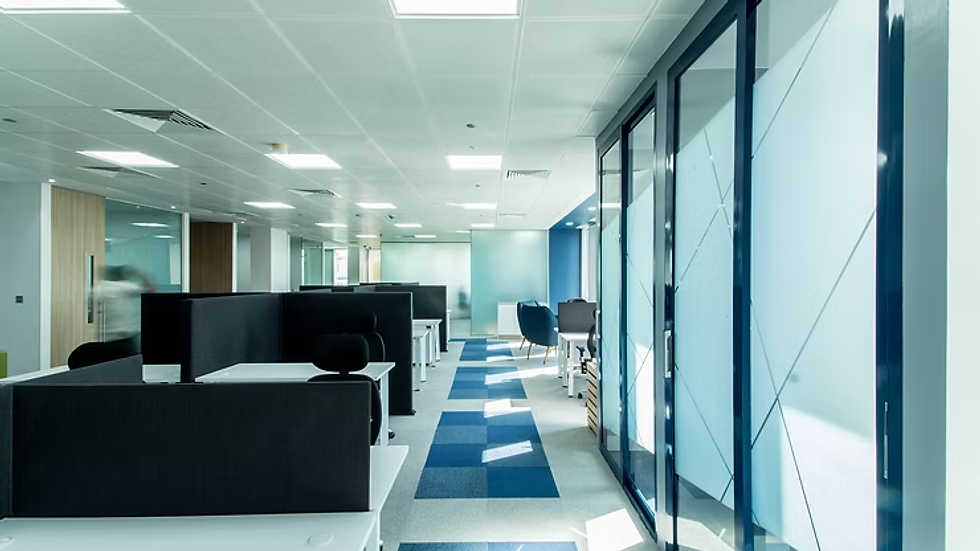The Architecture of Performance: Workspaces for Financial Leaders
- Chisom Oguama
- Aug 22
- 4 min read
Updated: Oct 28
In financial services, trust is currency, perception is leverage, and outcomes define longevity. The environments where these unfold are no longer passive backdrops; they are assets that shape confidence, credibility, and results.

Well-executed workspaces for financial leaders can boost productivity, strengthen investor confidence, and deliver measurable outcomes. Research from the Leesman Index highlights that high-performing workplaces consistently correlate with productivity gains. Meanwhile, Harvard Business Review notes that well-designed collaboration spaces can meaningfully improve the quality of decisions. In finance, those gains are not margins; they are market-shaping advantages.
Redefining Workspaces for Agility and Stakeholder Trust
Trust in finance is built on security, discretion, and credibility. A workspace that lacks these essential signals undermines confidence before a single transaction or negotiation begins. Leaders must design for confidentiality as intentionally as they design for capital strategy.
At Verod Capital, spatial reorganization was not implemented for aesthetics only. It was a strategic move. Acoustic zoning and investor-grade audio-visual systems created rooms where high-stakes negotiations could happen with confidence. Reorganized deal-team layouts enabled seamless collaboration without compromising privacy. The lesson is clear: secure, well-engineered spaces are trust accelerators that protect relationships and enhance credibility.

Ecosystem Thinking in Workspaces for Financial Leaders
Beyond trust, engagement has become the next strategic frontier. Today’s financial firms are ecosystems of stakeholders: investors, regulators, clients, and partners whose perceptions are shaped from the moment they enter a space.
Wema Bank understood this during its digital-first transformation. Its headquarters reception was reimagined as an engagement hub. Intelligent audio-visuals, interactive displays, and streamlined check-ins replaced static waiting areas. This environment signalled agility, digital maturity, and client-first thinking long before any presentation ever began. For stakeholders, the space itself communicated Wema’s ambition to lead in a fast-evolving sector.

Spatial Design as a Strategic Lever in Financial Institutions
For financial leaders, outcomes are not abstract. They are measured in talent retention, operational efficiency, and deal readiness. The right workspace translates directly into performance metrics and competitive edge.
Renmoney approached relocation as an opportunity to align culture with efficiency. A transparent atrium communicated openness. Optimized visitor flow reduced wait times, and custom writable trolleys encouraged spontaneous collaboration and problem solving. These deliberate design choices improved both productivity and creativity, turning workspace into a lever for measurable outcomes.

Shaping the Next Era of Finance
In financial services, the most valuable assets are not always on the balance sheet. They are in environments where strategies are forged, deals are secured, and trust is built. Purpose-built settings accelerate investor confidence, streamline operations, keep top talent engaged, and communicate executive intent before a single word is spoken.
The institutions that will define the next era of finance will not view their workspaces as overhead but as strategic infrastructure. For financial leaders, the mandate is clear: the environments you create today will determine the trust you earn, the engagement you inspire, and the outcomes you achieve tomorrow. Those who act with foresight will not only keep pace with the industry but set the standards others are forced to follow.
The Future of Financial Workspaces
As we look ahead, it’s essential to consider how the design of our workspaces will evolve. The future will demand flexibility and adaptability. We must create environments that can transform as needs change. This means incorporating technology seamlessly and ensuring that spaces foster collaboration and innovation.
Embracing Technology in Workspace Design
Technology is a critical component of modern workspace design. It enhances communication and collaboration. We can integrate smart systems that adjust lighting and temperature based on occupancy. This not only improves comfort but also boosts productivity.
Creating Collaborative Spaces
Collaboration is key in today’s financial landscape. We need to design spaces that encourage teamwork. Open areas, breakout rooms, and informal meeting spots can foster creativity and innovation. These spaces should be equipped with the latest technology to facilitate seamless communication.
Prioritizing Employee Well-Being
Employee well-being is paramount. Workspaces should promote health and wellness. Incorporating natural light, greenery, and ergonomic furniture can enhance the overall work experience. When employees feel good, they perform better.
The time for action is now. We must rethink our approach to workspace design. Let’s create environments that not only reflect our values but also empower our teams. Together, we can shape the future of finance, one workspace at a time.
In conclusion, the phrase "transform their office spaces into strategic assets" encapsulates our mission. We are committed to helping financial institutions thrive in a competitive landscape. Let’s embrace this journey together and redefine what’s possible in our workspaces.



Comments